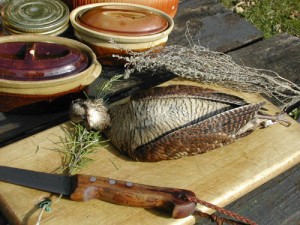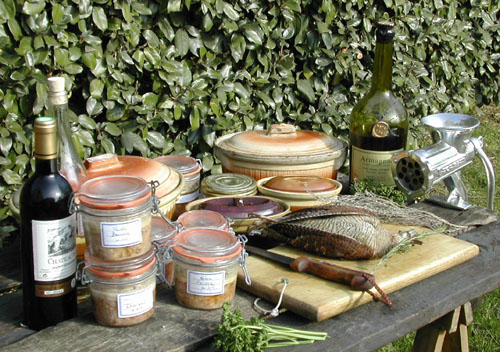From my friend from the French hunting fields and streams, Nick de Toldi www.gourmetfly.com
Home pâtés are prepared in three styles and each style should bear a proper name, which is not the case in normal life. La Terrine is the preparation cooked in an earthenware special oval-shaped pot. Small terrines exist for 250 or 300 grams, but it is common to make big terrines of 1-3kgs which serve quite a number of guests. Le Pâté is the same preparation, but cooked in a pie crust. If it adopts a round shape, it will be named a tourte. If it keeps the classic rectangular shape, it is more often named pâté en croûte. Or, your pâté can become a preserve, if cooked into the small parfait jars with rubber gaskets, which can be sterilized.
To determine your proportions, the first step is to weigh the amount of game you will use. Let’s take the example of a pheasant. Let’s say 800 grams. Then 800 grams of pork will be: 400 grams pork fat + 400 grams pork meat.
Take all the meat of your pheasant; keep also the heart, gizzard and liver. Grind it with the biggest holes of grinder that you can find. Otherwise chop with a knife making small pieces (the size of the chocolate chips for cookies).
Grind the pork fat. It must be fresh rather fat bacon or better some piece of throat bacon. The throat is usually not sold at butchers, but most often it can be ordered. It is the best fat part as the fat is very strong and appetizing; it does not melt liquid easily. The pork fat and meat are best ground with the same big holes. Grind the liver with any device. If you want to use full fillet or birds breasts, make the same preparation and fill your terrine with only half of it. Place on this in the center the fillet or the breasts and cover with the rest of the preparation -the breast or fillet must be seasoned with salt and pepper. Cook normally and when you will cut your slices you will discover a “heart” of prime morceau formed by the breast or fillet.
Then chop or grind 1 garlic tooth, parsley and a small onion or a shallot and mix thoroughly everything. Add salt -15 to 20 grams per kilo- pepper generously, and a spoon of fresh or dry thyme. Add 2 eggs and mix well. Add a small glass of Brandy, Cognac or Armagnac. There are regional variants with Calvados or Kirsch or prune brandy but the best flavour is given by Armagnac or Cognac. Mix well again. Refrigerate overnight.
– Fill a terrine with the preparation and cooked covered with foil or a lid, for two hours in a reasonably hot oven (200°C/400°F). Just uncover at the end to give a nice brown colour to the top. A bigger terrine takes a longer time.
– Or buy 2 rolls of pie crust at the supermarket and stuff it with the preparation.  This pâté en croûte will be ready in a shorter time -check the colour.
This pâté en croûte will be ready in a shorter time -check the colour.
– Or fill the jars that you want to preserve. I personally cook my jars at least 3 hours… take no risk.
In the terrine and in the jars there will be a liquid juice at the end of the cooking time (AND SOME OF THIS LIQUID MAY OVERFLOW FROM THE TERRINE WHILE BAKING, SO PUT A BAKING SHEET UNDER THE TERRINE TO AVOID SPILLING THE LIQUID TO THE BOTTOM OF YOUR OVEN). For the terrine, you must pour this in a bowl and mix with gélatine. You mix it well and pour again in the terrine. Upon cooling it will set. For the jars, a little bit of gélatine must be placed before closing the jars. I prefer the plaques of transparent gelatine. Otherwise, MAGGI makes a Gelée au Madère, which is prepared following the instructions and poured over the terrine until it fills all available space, something like 2 or 3 tablespoons for a jar and more for a terrine…
With the plaques of gélatine, do as follows: Boil in a casserole a half pint of white wine, seasoned with salt, pepper and a bay leaf. You can also blend a bit of Port or Madeira. When it has boiled and lost the alcoholic steam, melt in this 2 or 3 plaques of gelatine. If you make a terrine, then you will pour your gravy juice into your new mixture, mix well and put again in the terrine. If you sterilize jars then you will put 2 or 3 spoons on top of the meat in each jar.
To make it perfectly rectangular, you can cut a piece of cardboard to fit in the opening of the terrine, and the put a can of beans or other weight on the top, which the weight will force the meat into the corners of the mold and compresses it.
Serve with baguettes, French mustards, and cornichons.

